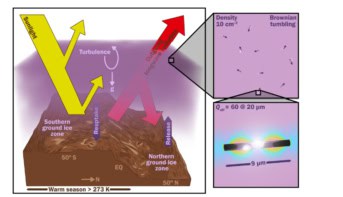
The effect of doubling atmospheric carbon dioxide on the climate becomes more pronounced as carbon dioxide levels rise – researchers in the US have shown. This effect, which had not been factored into previous estimates of the Earth’s radiation budget, explains about half the variation between estimates of the climate’s sensitivity to increased carbon dioxide. It also suggests a potential new approach to geoengineering.
The surface of the Earth is warmed by solar radiation and it emits infrared radiation back into space. However, much of this infrared radiation is absorbed by carbon dioxide and other gases in the lower atmosphere (the troposphere). This traps heat much like the glass of a greenhouse. Without this greenhouse effect, Earth would not be warm enough for liquid water and could not support life.
For the past two centuries human activity has been boosting the amount of carbon dioxide in the atmosphere – enhancing the greenhouse effect and warming the surface of the Earth and the troposphere.
Stratospheric effects
However, this description is a simplification. About 8–15 km above Earth’s surface lies the tropopause, and above this is the stratosphere. The stratosphere also absorbs incoming solar radiation and re-emits energy at infrared wavelengths – most of which goes back into space. As the stratosphere’s principal heat source is from above, it is warmest at the top.
“Whereas the troposphere is coupled to the surface by turbulent heat fluxes, the only heat exchange in the stratosphere occurs through radiation,” explains atmospheric scientist Brian Soden of the University of Miami in Florida. “When we’re adding carbon dioxide we’re increasing the emissivity at infrared wavelengths, which causes the stratosphere to want to emit more radiation.” This has to be included when calculating the “radiative forcing” of increasing carbon dioxide, which is a measure of how much an increase perturbs the Earth’s radiative energy balance.
Radiative forcing is a crucial parameter in climate predictions made by the Intergovernmental Panel on Climate Change (IPCC), but its accuracy has been questioned significantly for the past 30 years. For example, different models have disagreed by up to 50% on the radiative forcing resulting from doubling the atmospheric concentration of carbon dioxide. Now Soden and colleagues believe they can explain a significant part of this hitherto unexplained discrepancy.
Pre-industrial conditions
“Almost all previous calculations of the radiative forcing from carbon dioxide would take a climatology of temperature profiles from, say, pre-industrial conditions – so you would have a global distribution of temperature and humidity and 280 ppm carbon dioxide – and you would repeat that calculation, but instead of 280 ppm you’d double it,” explains Soden. “You could even do it with a range: we know that forcing from carbon dioxide increases not linearly but with the logarithm from 1 ppm to something like 10,000 ppm…But all of those calculations assume the same climatology – and that’s where there was a disconnect: you wouldn’t expect the same temperature and humidity profiles for 10 ppm as for 100 ppm or 1000 ppm.” The researchers therefore developed models of how radiative forcing would change as the carbon dioxide concentration in the atmosphere increased.
A counter-intuitive prediction that dates back to the first detailed predictions of anthropogenic climate change in the 1960s, and has been verified experimentally, is that the stratosphere cools because increased carbon dioxide raises its emissivity, causing it to lose more heat to space. Simultaneously, at the bottom the troposphere releases less heat because the increased carbon dioxide traps more infrared radiation.

Climate-change ‘fingerprint’ is identified in the upper atmosphere
“When you increase the emissivity, you have to reduce the temperature for [the stratosphere] to remain in radiative equilibrium.” This cooling means that, at higher carbon dioxide concentrations, the temperature drops further and it becomes more difficult for the Earth to radiate away heat. The radiative forcing of carbon dioxide therefore becomes ever larger. Every additional input of carbon dioxide therefore has a greater forcing effect.
Following this logic, the researchers are now looking at new ideas for geoengineering. Previous studies have focused on the use of aerosols that reflect sunlight back into space: “In this work, we are proposing to use absorptive aerosols to warm the [stratosphere] and lead to smaller carbon dioxide forcing, says Haozhe He, who led the work as Soden’s PhD student and is now a postdoc at Princeton University. This idea is supported by the fact that the 1991 eruption of Mount Pinatubo, which caused dramatic tropospheric cooling, was accompanied by stratospheric warming from sulphate aerosols.
“This is a very important [result] for the climate community – it resolves a major mystery as to whether or not we were faithfully treating the processes that drive global warming,” says William Collins of Lawrence Berkeley National Laboratory in the US, a coordinating lead author of the Sixth Assessment of the IPCC. “What [Soden and colleagues] have shown is that the climate community has been doing a much better job than we suspected for decades. The models were correct all along, we were testing them the wrong way. They were always producing a better answer than we thought.”
The research is described in Science.



